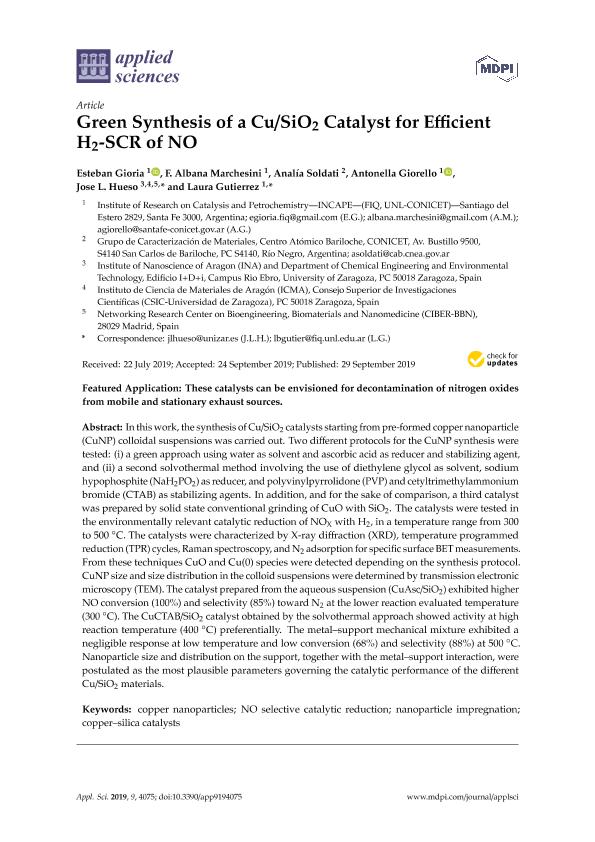Mostrar el registro sencillo del ítem
dc.contributor.author
Gioria, Esteban Gaston

dc.contributor.author
Marchesini, Fernanda Albana

dc.contributor.author
Soldati, Analía Leticia

dc.contributor.author
Giorello, Antonella

dc.contributor.author
Hueso, José Luis
dc.contributor.author
Gutierrez, Laura Beatriz

dc.date.available
2020-11-26T14:18:15Z
dc.date.issued
2019-09
dc.identifier.citation
Gioria, Esteban Gaston; Marchesini, Fernanda Albana; Soldati, Analía Leticia; Giorello, Antonella; Hueso, José Luis; et al.; Green Synthesis of a Cu/SiO2 Catalyst for Efficient H2-SCR of NO; Multidisciplinary Digital Publishing Institute (MDPI); Applied Sciences; 9; 19; 9-2019; 1-17
dc.identifier.uri
http://hdl.handle.net/11336/119094
dc.description.abstract
In this work, the synthesis of Cu/SiO2 catalysts starting from pre-formed copper nanoparticle (CuNP) colloidal suspensions was carried out. Two different protocols for the CuNP synthesis were tested: (i) a green approach using water as solvent and ascorbic acid as reducer and stabilizing agent, and (ii) a second solvothermal method involving the use of diethylene glycol as solvent, sodium hypophosphite (NaH2PO2) as reducer, and polyvinylpyrrolidone (PVP) and cetyltrimethylammonium bromide (CTAB) as stabilizing agents. In addition, and for the sake of comparison, a third catalyst was prepared by solid state conventional grinding of CuO with SiO2. The catalysts were tested in the environmentally relevant catalytic reduction of NOX with H2, in a temperature range from 300 to 500 °C. The catalysts were characterized by X-ray diffraction (XRD), temperature programmed reduction (TPR) cycles, Raman spectroscopy, and N2 adsorption for specific surface BET measurements. From these techniques CuO and Cu(0) species were detected depending on the synthesis protocol. CuNP size and size distribution in the colloid suspensions were determined by transmission electronic microscopy (TEM). The catalyst prepared from the aqueous suspension (CuAsc/SiO2) exhibited higher NO conversion (100%) and selectivity (85%) toward N2 at the lower reaction evaluated temperature (300 °C). The CuCTAB/SiO2 catalyst obtained by the solvothermal approach showed activity at high reaction temperature (400 °C) preferentially. The metal?support mechanical mixture exhibited a negligible response at low temperature and low conversion (68%) and selectivity (88%) at 500 °C. Nanoparticle size and distribution on the support, together with the metal?support interaction, were postulated as the most plausible parameters governing the catalytic performance of the different Cu/SiO2 materials.
dc.format
application/pdf
dc.language.iso
eng
dc.publisher
Multidisciplinary Digital Publishing Institute (MDPI)
dc.rights
info:eu-repo/semantics/openAccess
dc.rights.uri
https://creativecommons.org/licenses/by-nc-sa/2.5/ar/
dc.subject
COPPER NANOPARTICLES
dc.subject
NO SELECTIVE CATALYTIC REDUCTION
dc.subject
NANOPARTICLE IMPREGNATION
dc.subject
COPPER-SILICA CATALYSTS
dc.subject.classification
Nano-materiales

dc.subject.classification
Nanotecnología

dc.subject.classification
INGENIERÍAS Y TECNOLOGÍAS

dc.title
Green Synthesis of a Cu/SiO2 Catalyst for Efficient H2-SCR of NO
dc.type
info:eu-repo/semantics/article
dc.type
info:ar-repo/semantics/artículo
dc.type
info:eu-repo/semantics/publishedVersion
dc.date.updated
2020-11-25T17:32:00Z
dc.identifier.eissn
2076-3417
dc.journal.volume
9
dc.journal.number
19
dc.journal.pagination
1-17
dc.journal.pais
Suiza

dc.journal.ciudad
Basel
dc.description.fil
Fil: Gioria, Esteban Gaston. Consejo Nacional de Investigaciones Científicas y Técnicas. Centro Científico Tecnológico Conicet - Santa Fe. Instituto de Investigaciones en Catálisis y Petroquímica "Ing. José Miguel Parera". Universidad Nacional del Litoral. Instituto de Investigaciones en Catálisis y Petroquímica "Ing. José Miguel Parera"; Argentina
dc.description.fil
Fil: Marchesini, Fernanda Albana. Consejo Nacional de Investigaciones Científicas y Técnicas. Centro Científico Tecnológico Conicet - Santa Fe. Instituto de Investigaciones en Catálisis y Petroquímica "Ing. José Miguel Parera". Universidad Nacional del Litoral. Instituto de Investigaciones en Catálisis y Petroquímica "Ing. José Miguel Parera"; Argentina
dc.description.fil
Fil: Soldati, Analía Leticia. Instituto Nacional de Tecnología Agropecuaria. Centro Regional Patagonia Norte. Estación Experimental Agropecuaria San Carlos de Bariloche. Instituto de Investigaciones Forestales y Agropecuarias Bariloche. - Consejo Nacional de Investigaciones Científicas y Técnicas. Centro Científico Tecnológico Conicet - Patagonia Norte. Instituto de Investigaciones Forestales y Agropecuarias Bariloche; Argentina
dc.description.fil
Fil: Giorello, Antonella. Consejo Nacional de Investigaciones Científicas y Técnicas. Centro Científico Tecnológico Conicet - Santa Fe. Instituto de Investigaciones en Catálisis y Petroquímica "Ing. José Miguel Parera". Universidad Nacional del Litoral. Instituto de Investigaciones en Catálisis y Petroquímica "Ing. José Miguel Parera"; Argentina
dc.description.fil
Fil: Hueso, José Luis. Universidad de Zaragoza. Instituto de Nanociencia de Aragón; España
dc.description.fil
Fil: Gutierrez, Laura Beatriz. Consejo Nacional de Investigaciones Científicas y Técnicas. Centro Científico Tecnológico Conicet - Santa Fe. Instituto de Investigaciones en Catálisis y Petroquímica "Ing. José Miguel Parera". Universidad Nacional del Litoral. Instituto de Investigaciones en Catálisis y Petroquímica "Ing. José Miguel Parera"; Argentina
dc.journal.title
Applied Sciences
dc.relation.alternativeid
info:eu-repo/semantics/altIdentifier/url/https://www.mdpi.com/2076-3417/9/19/4075
dc.relation.alternativeid
info:eu-repo/semantics/altIdentifier/doi/http://dx.doi.org/10.3390/app9194075
Archivos asociados
